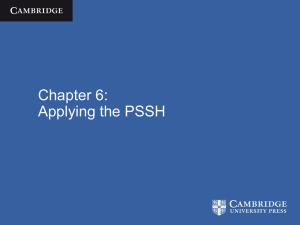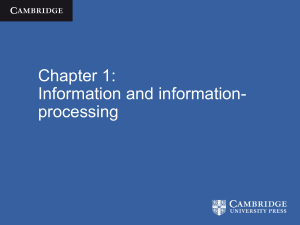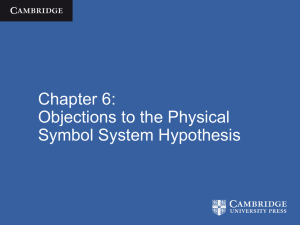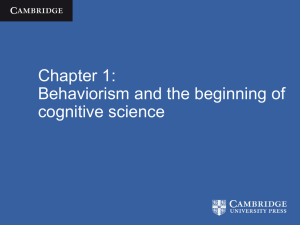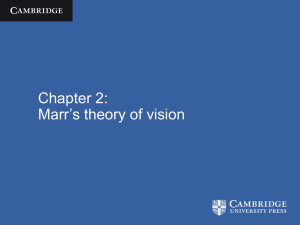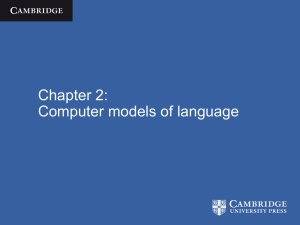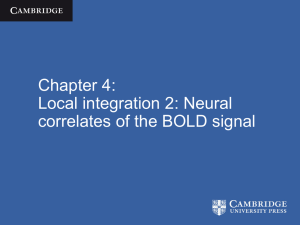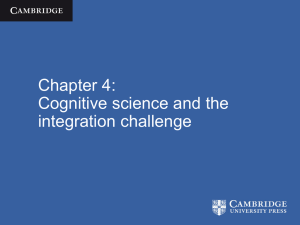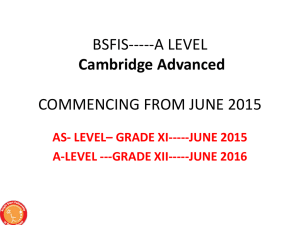Modeling mental imagery
advertisement
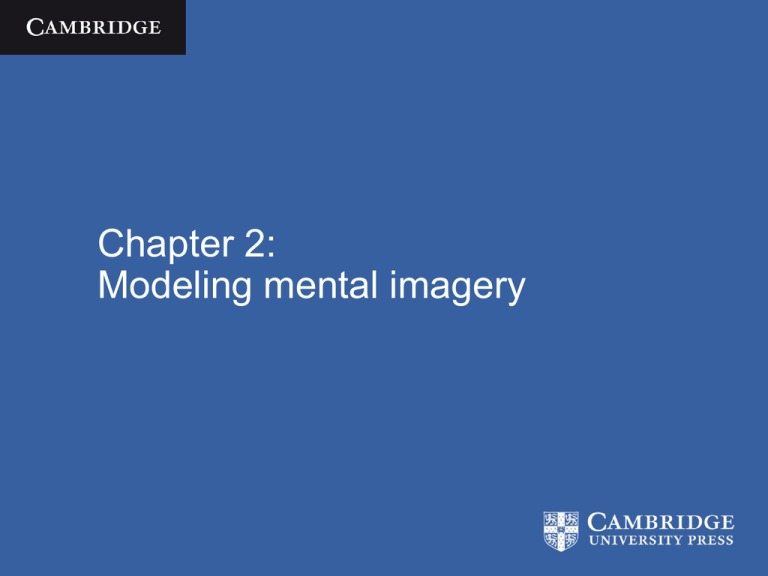
Chapter 2: Modeling mental imagery The ingredients •Encountered some of the basic ideas feeding into cognitive science • move away from associationist models of learning and behavior • information theory as a tool for exploring the nature and limits of cognitive abilities • development of “boxological” accounts of how cognitive tasks can be performed • theory of computation as a model for information-processing Cognitive Science José Luis Bermúdez / Cambridge University Press 2010 Putting them together: 3 case studies • Terry Winograd and SHRDLU [TODAY] • The imagery debate [MONDAY] • Marr’s theory of vision [WEDNESDAY] Cognitive Science José Luis Bermúdez / Cambridge University Press 2010 Earlier themes •The nature of mental representation – Miller and chunking informationprocessing depends on how information is coded – Winograd and procedural semantics representation of “knowledge” in terms of algorithmic routines Cognitive Science José Luis Bermúdez / Cambridge University Press 2010 Common assumptions about information •Information is amodal • Miller’s suggestion that the sensory systems all have the same channel capacity •Information is coded in a digital/propositional format • based on the formal languages used to program computers Cognitive Science José Luis Bermúdez / Cambridge University Press 2010 Digital information-coding •Information is coded in a format that has the basic properties of a language • Basic constituents are individual symbols • Compositionality – complex structures are built up from individual symbols according to formation rules • Arbitrary connections between symbolic structures and what they represent Cognitive Science José Luis Bermúdez / Cambridge University Press 2010 Digital information-processing •The model for thinking about digital information-processing are formal languages (e.g. logical languages and computer programming languages) •Model information-processing on, e.g. • proofs in logical languages • implementation of instructions in a production system Cognitive Science José Luis Bermúdez / Cambridge University Press 2010 Imagistic information-coding •Non-symbolic: images are not built up from basic elements •Not compositional • The parts of images cannot reoccur in other images • No rules for building up images from their parts Cognitive Science José Luis Bermúdez / Cambridge University Press 2010 Representation in images •Representation depends upon systematic correlation between properties of representation and properties of what it represents • pictorial depiction depends upon resemblance • can be schematic resemblance, as in a map Cognitive Science José Luis Bermúdez / Cambridge University Press 2010 Tricky issues •Imagistic representations can exploit symbols (e.g. maps) • need to distinguish between the representation and the labeling of the representation •Imagistic representations ≠ analog representations • a representation is analog just if it permits continuous variation • there are examples of analog representartions that are not imagistic and imagistic representations that are not analog Cognitive Science José Luis Bermúdez / Cambridge University Press 2010 Imagistic information-processing •The real issue comes with how information is extracted from imagistic representations • scanning images • manipulating images (e.g. rotation) •Certain types of information are much easier to extract from images than from digital representations Cognitive Science José Luis Bermúdez / Cambridge University Press 2010 The issues for cognitive science •Is information always encoded in a digital format - or are there cases of imagistically encoded information? •How can we explore this experimentally? • By looking at how subjects carry out information-processing tasks involving images • Seeing whether their behavior provides indirect evidence that they are scanning/manipulating images Cognitive Science José Luis Bermúdez / Cambridge University Press 2010 Brooks 1968 F • Form a memory image of a capital F • Trace around the image, starting at the bottom left corner and working clockwise • Indicate for each corner whether it is on a top edge of the figure • Performance is impaired when responses are made visually (i.e. by pointing to the word ‘Yes’), rather than by saying ‘yes’ Cognitive Science José Luis Bermúdez / Cambridge University Press 2010 Cognitive Science José Luis Bermúdez / Cambridge University Press 2010 Cooper 1975 Cognitive Science José Luis Bermúdez / Cambridge University Press 2010 Scanning mental images Cognitive Science José Luis Bermúdez / Cambridge University Press 2010 The strong interpretation • Subjects perform the task by rotating/scanning mental images in their “mind’s eye” • The process of mental rotation/scanning has is structurally similar to physical processes of rotation/scanning • Seems to match evidence from introspection Cognitive Science José Luis Bermúdez / Cambridge University Press 2010 Problems with the strong interpretation • Dennett’s “Cartesian theatre” • Who or what is doing the scanning/rotating? • Where is the image projected? • Threat of regress if we take the metaphor of the “mind’s eye” literally • Not clear how these mental images relate to “phenomenal images” Cognitive Science José Luis Bermúdez / Cambridge University Press 2010 Kosslyn’s theory • Develops metaphor of images as spatial displays on cathode ray tube • Mental images are temporarily generated from propositionally encoded information in long-term memory • Mental images “projected” onto visual buffer (which is where perceptual representations also appear) Cognitive Science José Luis Bermúdez / Cambridge University Press 2010 Solving a problem Cognitive Science José Luis Bermúdez / Cambridge University Press 2010 Ambiguity • Personal-level phenomena • phenomenal images • conscious experience of the world • accessible to introspection (not always reliable) • Subpersonal information-processing explains our personal-level phenomena and abilities Cognitive Science José Luis Bermúdez / Cambridge University Press 2010
